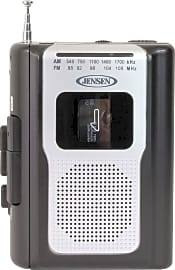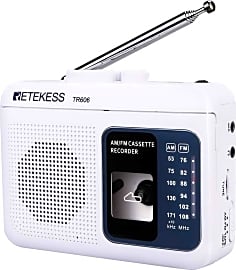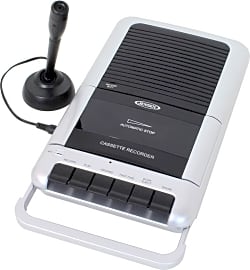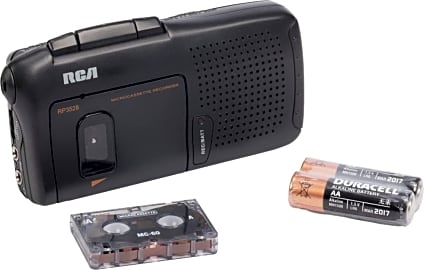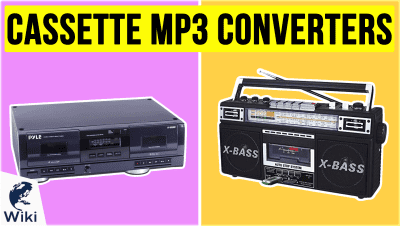The 10 Best Cassette Recorders

This wiki has been updated 34 times since it was first published in October of 2016. Nowadays, when people want to record audio, they pull out their cell phones. But if you've got a taste for vintage hardware, you might appreciate what the cassette recorders on our list have to offer. We've included some models that will simply record and play back, as well as others with more modern features, like USB ports and auxiliary jacks you can use to digitize your old mixtapes. When users buy our independently chosen editorial choices, we may earn commissions to help fund the Wiki.
Editor's Notes
November 03, 2020:
There are two main functions for these cassette recorders: to record music, either from the radio, other cassettes, or digital files, and to record one's own voice. If you're planning to do one, then it doesn't make a lot of sense to pay for the other. That's why the Semier Compact is on top - it's inexpensive, good for voice recording, and a solid pick for those who want to listen to music on the go. The Jensen Portable and Byron Statics Automatic are around the same size, while the Jensen MCR-100 is a bit bigger but has a mic.
If it's music you're hoping to record, the Tascam Double is the clear winner, though it's quite pricey and therefore unnecessary if you don't know how to use its many features. There's a good chance this purchase is for a senior citizen, and with that in mind, simplicity and ease of use are worth considering. That's why the Victrola Mini, Semier Boombox, and Retekess TR606 are all worthwhile picks.
While things like Bluetooth connectivity, voice-activated recording, and power adapters are all good features, they aren't useful for everyone, so know your recipient. Is this for the home? Get a unit with an AC adapter. Do you want to stream music to it? Check out the Victrola Mini. Just don't invest too much into a cassette recorder without understanding that no amount of bells and whistles can change the fact that cassette tapes are largely obsolete.
December 22, 2019:
While this is certainly a slow-moving category due to the obsolete nature of the medium, there is continued interest in vintage-style recorders, as well as models that can reliably convert old tapes to MP3s. This is probably truer for old family tapes that feature the voices of loved ones since past than it is for anyone's old Leonard Skynard cassettes, so when it came time to scrutinize bit rate, 128kbps was plenty, even if it falls far short of CD standards, and barely meets the standards we get from streaming audio. The two new models we've added to our list both fall into this converter category, in the OfficeLead Retro Converter and the Rybozen Portable Converter, both of which are actually quite similar but for the fact that the Rybozen model has a harder time keeping the speed of its gears consistent, which can cause slight warping in the final files.
To make room for those two new models, we got rid of the Broksonic Walkman and the Jaras Limited Edition from our previous list, both of which had some durability issues. The Broksonic also had some insurmountable tape speed issues that were all the more problematic when you consider that it's meant to be used as a Walkman as much as anything else.
More traditional full-sized and microcassette recorders still offer the best overall sound quality for taping lectures and taking dictation, though, and the Panasonic RQ2102 still offers the best combination of fidelity, ease of use, and durability.
October 22, 2018:
Quality control issues knocked the Quantum FX J21U down a fair number of spots on this year's list. There was also a greater number of simpler, more effective models that earned high spots due to their reliable performance, which is integral when working with older technologies. The Panasonic RQ2102 is a great example of this reliability. Some of those options are on the expensive side, but their quality is undeniable.
Special Honors
Tiger Talkboy Yes, the very same device used by Kevin in the classic film "Home Alone 2: Lost in New York" can be yours for the right price. Though you aren't likely to find a brand new model, any wear and tear will just add to the retro cool factor. ebay.com
A Truly Magnetic Personality
What does an aging shepherd from circa 2000 B.C.E. Greece have in common with the majority of 1980s pop music?
What does an aging shepherd from circa 2000 B.C.E. Greece have in common with the majority of 1980s pop music? Not a whole lot, but their legacies were both made possible thanks to the wonders of magnets. As legend would have it, the shepherd Magnes of Magnesia stumbled upon a black rock roughly 4,000 years ago, and to this rock clung the metal in his shoe nails and the tip of his staff. As he dug up lodestones full of magnetite ore, he possibly became the first human being ever to intentionally manipulate a magnet, and got an entire peninsula and archipelago in Eastern Greece named after himself.
Later on, about a half century before the musicassette blew up, Fritz Pfleumer was hard at work in Dresden. He was trying to convert a decades-old means of recording onto magnetic wire into something a little more useful. As any good inventor would, he had begun in a quest to supply an elegant, yet inexpensive golden-striped cigarette paper for the modern gentleman's enjoyment — a respectable endeavor, indeed. When he beheld the beauty of his smoking paper, however, he was immediately struck with the notion to turn his luxurious creation into a musical storage medium, because nothing goes with a good smoke quite like some pleasant tunes. So he put a layer of ferric oxide on some 16-millimeter-wide paper, and loaded it onto the reels of a one-of-a-kind tape machine. Three hundred meters later, he produced a 20-minute recording that sounded terrible yet laid the groundwork for future magnetic recording.
Many cutting-edge developments remained sequestered in Germany until after the Second World War. Throughout the 1950s and 1960s, varying tape-based systems came and went, often designed for the suddenly ubiquitous automobile. Vinyl records still command the respect of music buffs today, even if their "warm tone" is actually just distortion. But you cannot put a turntable in a car, so the compact cassette took the reins for over 20 years as the medium of choice for popular music.
The Modern Musicassette
In 1979, as tape manufacturers were finally delivering respectable audio in comparison to vinyl, Sony essentially created the portable audio field with the release of the iconic Walkman, cementing the cassette's place in history. This new and popular standard was an entirely different beast from Fritz's creative, yet inefficient reel-to-reel system. It abandoned the tear-prone paper for durable and thin polyester film. On this film there are two tracks, in the case of monaural sound, and four in the case of stereo. Half of these tracks were oriented in one direction, and half in the other, which effectively doubled the unit's total capacity. It also necessitated an action familiar to vinyl fans of the previous decades: the flip. Just like an LP record, there's a break in the middle of every tape. Unlike records, however, tapes are easy to reverse mechanically.
Walk into nearly any one in the country and somewhere you'll see a shelf lined with rows of cassette releases.
Speaking of flipping, old cassettes are often flipped to the consumer at ridiculously affordable prices, notably at thrift stores and garage sales. Walk into nearly any one in the country and somewhere you'll see a shelf lined with rows of cassette releases. And they're not just dirt cheap: it's not unheard of to score a hard-to-find album on those shelves for next to nothing, and in truth, Spotify and the iTunes store simply don't offer every single cassette release from the eighties.
The tape's recordable nature certainly contributed to its rise, as this gave it immensely more utility than vinyl. In fact, cassettes were originally developed exclusively for dictation machines, which makes sense when you consider the poor sound quality they produced at first. As it turns out, this initially lo-fidelity product was the perfect template for end-user music recording, once materials and construction improved. One particular dreadlocked and free-spirited community held this flexibility in high regard, as "tapers" recording the Grateful Dead inspired a tradition that many bands' fans carry on to this day.
How They Work
The most important part of a cassette is, well, the tape. Not the sticky kind, of course, but a thin and strong polyester film, coated with magnetically sensitive particles (usually iron oxide). As the head unit passes over this material, it doesn't actually move the particles, but leaves its mark in the form of magnetic charge. The individual oxide particles are as small as 0.5 micrometers each, which allows the tape to hold the four tracks required for two-sided, stereo playback.
As the head unit passes over this material, it doesn't actually move the particles, but leaves its mark in the form of magnetic charge.
They do have a few inherent drawbacks, however. Their recordings suffer catastrophic damage if exposed to even relatively small magnetic forces. And while the MP3 vs. vinyl debate rages on, you'll likely not find many proponents of vintage tapes, unless they're particularly fond of buzzing, hissing, and distortion (incidentally, many people do like such artifacts, and lo-fi tape loops continue to occupy an important artistic niche today). Finally, the lifespan of a cassette tape is finite, and shorter even than that of optical media. While a cassette can't scratch like a CD can, its all-important charge simply tends to dissipate over time.
In the 21st century, even 1900s-era technology gets a boost. Today's cassette components are of considerably higher quality than the originals, all the way from the microphone to the longevity of the cassette itself. You may notice that many different options are styled much like their 30-year-old counterparts, which is by design — similar to vinyl, nostalgia plays a role in cassettes' continued popularity. The modern versions are also quite a bit more reliable, and thankfully will almost never result in a rat's nest of tangled plastic, something older machines were notorious for. You'll also find reliable onboard editing options, like precise over-dub controls, multi-band equalizers and built-in MP3 conversion. Even though modern technology has mostly moved on from cassettes, it hasn't forgotten them; you can still dub your favorite mixtape straight from FM radio, if you so desire.





